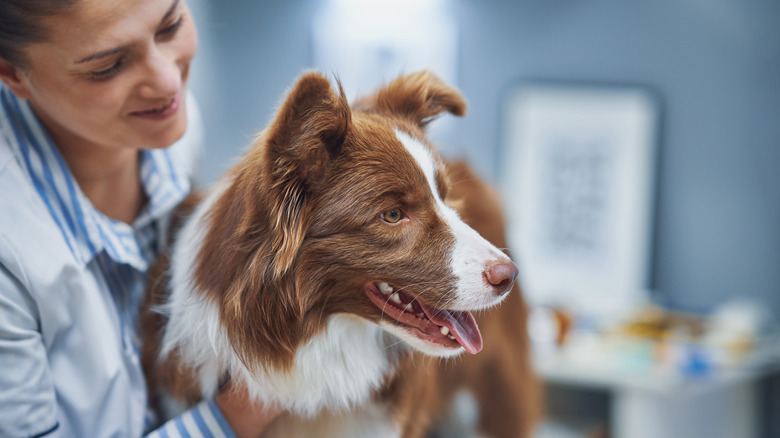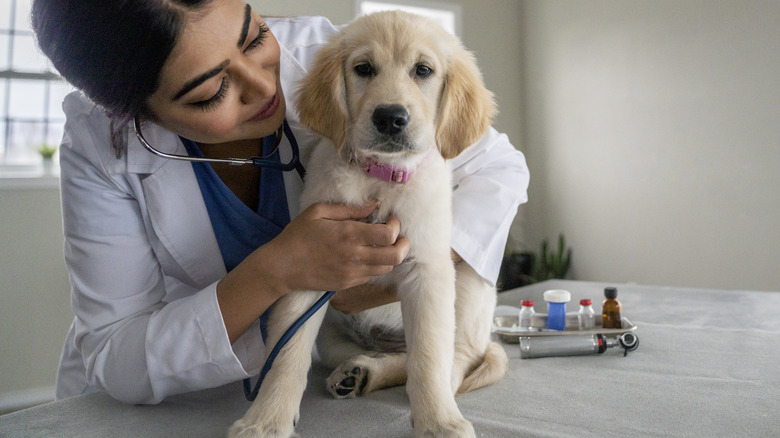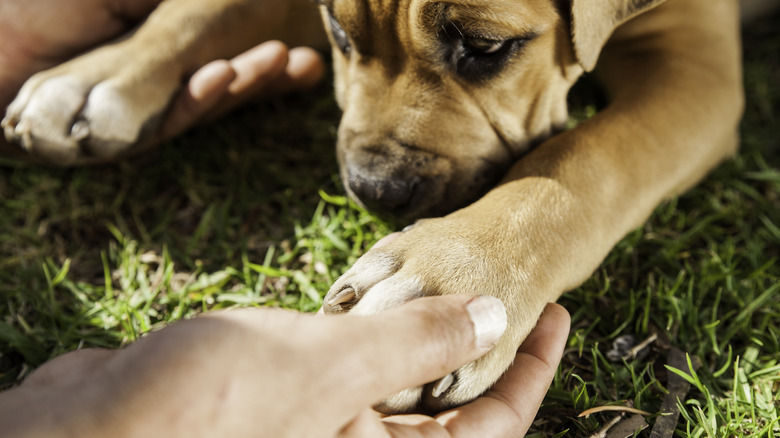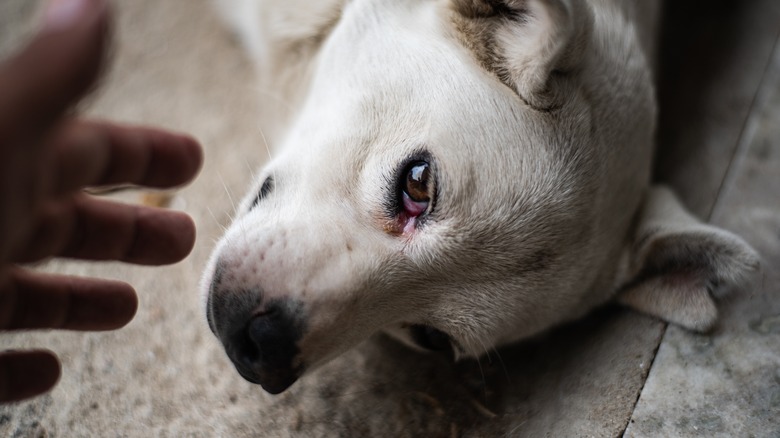Serious Symptoms You Shouldn't Ignore In Your Dog
Monitoring your dog's health is a core duty of pet parenthood, allowing you to better ensure their continued happiness and safety. Yet, whether you are a first-time or a seasoned caretaker, this ongoing awareness can be a source of anxiety. It is perfectly natural to feel that way, but the difficulty of gauging whether a symptom merits an emergency visit is often understated. Dogs sometimes communicate pain or distress; however, under other circumstances, they may hide their symptoms as a natural response.
How do you distinguish between a limp from aggressive play and a fracture or determine when a cough is "normal" or a sign of a more significant issues? These questions can be hard to answer. You may struggle to interpret your canine companion's sudden change in behavior or health, especially if you're new to pet parenthood. If you ever feel uncertain about whether you should reach out to your vet for advice, go ahead and make the call, especially if several of the symptoms discussed below show up simultaneously. Even on their own, these signs should not be ignored.
Skin changes
You may not always think about your dog's skin color; we have affectionate names like "furry friends" for our adorable companions for a reason after all. Yet familiarizing your dog with having their ears, gums, and tummies checked and taking note of their natural color is an ideal way to help monitor any health changes. For example, redness around the ear canal could be an early symptom of an ear infection, whereas a wound that does not heal might indicate cancer. You can spot a wide range of issues by simply being mindful of any changes to your pooch's skin.
Yellowing skin, a sign of icterus (jaundice), is a major red flag. Per VCA Animal Hospitals, it could indicate the destruction of red blood cells, liver disease, or an obstruction in the bile duct. Your dog's gums are an ideal place to check for skin color changes. Any yellowing will be noticeable there, and this also allows you to keep an eye on your pup's teeth to stay on top of and prevent dental disease. Pale or white gums in your pet should be an immediate cause for concern and a veterinarian visit.
Changes to eye color
Many people love looking into their dogs' eyes. They express so much through their gazes, including a brightness and love that is as infectious as it is uplifting. Eye changes may be easier for pet parents to spot than alterations to the skin, particularly if the dog is sensitive about having their ears and gums touched. Thankfully, symptoms like jaundice will also appear in this area. Additionally, there are eye-specific conditions that you shouldn't ignore.
A dog displaying cloudy eyes can be a sign of glaucoma, cataracts, or other underlying issues. Eye redness generally stems from a mix of irritation and inflammation, which can indicate many problems, from allergies to conjunctivitis (more commonly known as pink eye). Other difficulties can be breed-specific, such as ectropion, the drooping or folding of the bottom eyelid typically found in bulldogs and bullmastiffs. A slight droopy eye in these breeds shouldn't be a point of concern, but it could be an issue if coupled with inflammation. Animal Eye Care has a handy list of breeds predisposed to eye conditions to keep in mind.
Trouble urinating
It can be challenging to gauge how much your dog is peeing outside, but there are telltale signs that they are experiencing difficulty that you can look out for. Your dog may fail to urinate multiple times, have leaks at home, and, in severe cases, experience abdominal pain and distension. Any other symptoms appearing with urinary retention, such as vomiting, require a call to your vet.
Such signs could indicate many different problems for your canine. Like humans, dogs can suffer from obstructions ranging from kidney stones to blood clots. For those who have ever experienced a UTI, pups can also develop the same issues with persistent and frequent trouble urinating. In more severe cases, urinary retention could point to a cancerous growth or kidney problems.
The opposite is an overly active bladder, which caretakers should be mindful of; it is often accompanied by your pet overdrinking. Urinary incontinence can be a side effect of a UTI or cancer, but it also comes with its unique issues, such as inflammation of the bladder or prostate problems in male dogs. Excessive urination and thirst could also be a sign of diabetes, which is important to spot early to ensure your pooch has a long, healthy life despite the condition.
Breathing issues
Certain breeds of dogs, such as boxers and pugs, are inherently more prone to breathing troubles than others. While you should be aware of the conditions your pet is predisposed to, there is a difference between breed-specific and irregular respiratory problems. Wheezing, heaving, and, in the most severe case, choking may require care or emergency medical service. Knowing your dog's natural breathing pattern will also help determine any changes. Virginia-Maryland College of Veterinary Medicine has a handy YouTube video to show you how to measure your pup's breathing rate.
According to Metropolitan Veterinary Associates, symptoms of respiratory issues include labored or shallow breathing, coughing, and gagging. Signs of oxygen deprivation can appear through a bluish tongue or gums and lethargy. Discomfort or difficulty breathing can be a indicator of anything from an acute allergic reaction to breed-specific issues like laryngeal paralysis. If your dog is choking and you can tell something is stuck in their throat, you can take steps to provide immediate assistance; learning what to do in advance is recommended.
Loss of appetite
Depending on your dog, it may be challenging to gauge whether they have lost their appetite. Some canines will self-regulate their eating and may miss meals without it affecting their health. An excellent way to gauge this is to measure their food and take note of any skipped chow times. Knowing how much you should feed your dog based on weight and age and tracking their habits will help you notice a loss in appetite early.
Like humans, appetite loss can be a sign of numerous problems. When people find themselves unable to eat, it can stem from various medical causes, and your little furry companions are no different. Issues can range from gastrointestinal diseases to discomfort with their teeth. A lack of appetite may not be urgent, but keeping track of your dog's food intake will let you know when you need to contact your veterinarian.
Weight loss is bound to happen with a loss of appetite, but there is also the potential for abnormal weight loss despite consistent food consumption. If your dog is eating regularly but still losing weight, this could be an issue of nutrition, a change in activity levels, or a hypermetabolic state where they burn more calories than they take in. Your vet should weigh your dog during every visit, but if you are unsure what a healthy weight looks like, the Association for Pet Obesity Prevention has a helpful chart organized by breed.
Excessive pacing and restlessness
We have all experienced a dog's excitement about going on a walk, the sound and smells of their food being readied, or preparing for their favorite outdoor activities. Excitement arises based on the stimulus the canine experiences, which is just one of their many cute features. However, if you notice that your pup's energy becomes unmanageable, including but not limited to trying to lay down but getting back up or attempting and failing to sleep, this can indicate more significant issues.
Excessive movement and agitation can be a simple sign of anxiety brought on by anything from fireworks to boredom. However, this behavior could signal problems with liver function, the onset of canine cognitive dysfunction (dog dementia), or an ear infection, just to name a few. As anxiety remains the most common cause of restlessness in dogs, you can do several things at home to help your pooch adjust. Cornell University of Veterinary Medicine offers a handy guide to the causes of anxiety in your pet and ways to help alleviate it.
Mobility issues and limping
Problems with mobility can be a sign of aging, and, like humans, the older a dog gets, the harder certain activities can be on their joints. Issues with movement can be a sign of less urgent problems developing, such as arthritis, hip strain, obesity, or neurological issues, all of which may be treatable. One of the more common problems dog parents will encounter is limping. Many pups live very active lifestyles and enjoy playing with their furry friends at the local park. Sprains happen, but when you see a tumble and hear that yelp, your brain may tend to go into overdrive. So, how do you tell the difference?
A fracture is a possible crack, split, or break, while a sprain affects the ligaments. Observe the location where your dog has been injured. Any external injuries or distortion of the leg are signs of a fracture. Keep an eye on your canine's movement, how much discomfort they are in, and if they face any challenges walking. You want to give them some time to heal up; most minor sprains will pass within 48 hours. Fractures or limping past that timeframe warrant a visit to the vet.
Lethargy or weakness
Lethargy or weakness in your dog can be difficult to gauge, especially when it comes to seasonal changes. Certain breeds are much more happy to lounge in their favorite outdoor bed through the hottest days of summer. To tell if your pup is lethargic after their favorite activities or time spent outside, monitor their rest; if they wake up and still display the same fatigue or lack of excitement for other pastimes or treats, start keeping a closer eye on their behavior and see if it passes. If your pet doesn't react to any stimulus, this is likely severe lethargy and should be addressed with a vet immediately.
Changes to your dog's energy levels can stem from a range of issues. Lethargy may result from environmental hazards, like the ingestion of poisonous materials, or conditions such as diabetes or arthritis. If your pooch takes medicine for the first time, such as antibiotics, this can impact their energy levels too. For new pet parents, it can certainly be hard to tell between normal and moderate lethargy at a glance. Be mindful of other symptoms, like vomiting or difficulty breathing. If you have concerns, don't hesitate to speak with your vet.
Coughing
Dogs explore the world through their senses, using their nose and mouth to investigate everything. The occasional cough should not be a cause for concern. However, persistent coughing and the type they exhibit could be indicators of more troubling issues, though this can still confuse a lot of owners. In a viral TikTok video, Dr. Michele Forbes notes, "Rarely do [dog owners] identify a cough until it becomes an overt problem and it's clearly coming from the chest." Comparatively, major reactions, such as a high-pitched gagging or severe cough with wheezing, could be signs of choking or respiratory issues that require immediate care.
Canine infectious tracheobronchitis (commonly referred to as kennel cough) is one of the most prevalent diseases in dogs, and its symptoms will often dissipate within one to two weeks. Kennel cough is highly infectious. Even if you believe your dog has contracted it and is managing their symptoms, it is important to take them to the vet to help prevent it from spreading further. The American Kennel Club offers an in-depth explanation of this common condition and how treatment works.
Fever or abnormal temperatures
Fever and abnormal temperatures can be challenging to spot in your dog. You can save yourself a lot of concern by learning how to identify canine fevers and treat them at home. Knowing what a safe outside temperature is for your dog is equally important. Pups can struggle with extreme temperatures just like us. They can get overheated or cold and develop fevers when dealing with certain illnesses. Fevers, in particular, can indicate underlying conditions, ranging from bacterial infections to ingesting poisonous materials.
Overheating comes with its signs, such as excessive panting and drooling, rapid breathing, vomiting, or disorientation. Pet parents will also want to be mindful of cold temperatures and breed limitations; Huskies can withstand -75 degrees Fahrenheit and still function outside, while your pet Chihuahua will struggle with temperatures dropping under 40 degrees Fahrenheit. Be aware of signs of hypothermia, such as cold limbs, changes in breathing, shivering, excessive urination, and lethargy. Always dress your dog appropriately for the weather.
Blood in urine or feces
Blood appearing in your dog's urine or poop is always going to be a cause for immediate concern. Seeing blood where it should not be will make anyone uneasy. Yet this may not be the emergency that you think it is, as the reasons for the occurence can vary drastically.
Blood in the poop can appear in one of two forms, melena or hematochezia feces. Melena, which appears black and tarry, primarily originates from the front end (mouth to stomach). Hematochezia, more visible in its bright red appearance, is often a sign of bleeding in the gastrointestinal tract. The range of what either means varies greatly and can be as mild as stress or bacterial infection to more severe like pancreatitis and liver or kidney disease.
Blood in urine can also be challenging to detect at a glance. If you cannot determine the urine color when your dog pees outside, getting them to pee on a white paper or cloth will help determine if blood is present. Blood in urine can appear pink, red, orange, amber, or brown. The problems the appearance of blood can point to are numerous, from a UTI to a bladder or kidney stone.
Vomiting
If you have lived with a dog for any period of time, you know that vomiting happens. An irritated stomach or gastrointestinal issues come with the territory, especially for those ground gobblers who like to steal anything resembling food on their walks. If your dog vomits once or twice but seems to recover after and shows no other symptoms, there is likely no cause for concern. Many confuse vomiting with regurgitation. Regurgitation is often easy to recognize; it will come up suddenly and look like the last thing your dog ate.
Vomiting, on the other hand, often has early signs such as drooling, heaving, or retching. When paired with other symptoms, like lethargy and weight loss, vomiting can point to more severe underlying issues. The amount of vomit and its consistency should also be examined (as gross as that may seem). A dog throwing up white foam is a sign of a common challenge faced by pet parents: acid reflux. Comparatively, bright green or dark (brown or black) vomit can be a indication of poisoning that requires immediate follow-up. Dr. Jason Gagné, DVM, DACVIM, wrote a helpful guide to the various types of vomit and their potential meanings for Purina.
Fainting, seizures or strokes
Fainting, seizures, and strokes are different symptoms your dog may exhibit, but all are equally panic-inducing. Syncope, the medical term for fainting, happens when your pet experiences a lack of oxygen or nutrients in the brain. This is always a cause for immediate medical follow-up and is normally easy to spot, as fainting involves a full collapse and stiffness in the limbs and body.
It can be challenging to tell the difference between a canine seizure and a stroke. A seizure is brought on by a brain malfunction, which causes the dog to lose control of their body. This response varies in intensity and can be a singular or recurring event; certain breeds, such as beagles and golden retrievers, are more prone to seizures. Southeast Veterinary Neurology's YouTube channel has put together a video that highlights how to notice a seizure and provide immediate care.
Strokes can be less debilitating in dogs than in people, but they are still concerning as they can point to various underlying problems. While a stroke is the result of blood flow issues instead of brain malfunctions, it will be difficult for most individuals to distinguish between the two thanks to the many overlapping signs. Fainting, seizures, and strokes all require immediate veterinary care.
Abdominal enlargement
The reasons for severe abdominal enlargement can vary, but it is always a medical emergency. Rapid expansion of the stomach combined with gastric dilatation and volvulus (GDV) will not only cause your dog physical pain but can also lead to organ damage and pressure on the diaphragm, resulting in breathing issues. In the most severe circumstances, a stomach rupture or damage to the spleen can occur. Reasons for bloat with GDV remain largely unknown, though it is more common in heavy-set and larger dogs.
As alarming as bloat is, the condition typically has other telltale signs, so you don't have to feel obliged to always keep your eye on your dog's tummy. Dry heaving, excessive panting and drooling, anxiety, collapsing, and stomach swelling are all clear indicators, per PetMD. Your pooch taking the downward dog stance can signal that they are trying to relieve their severe discomfort. There are no home remedies for bloat; rather, you should always seek medical intervention.














